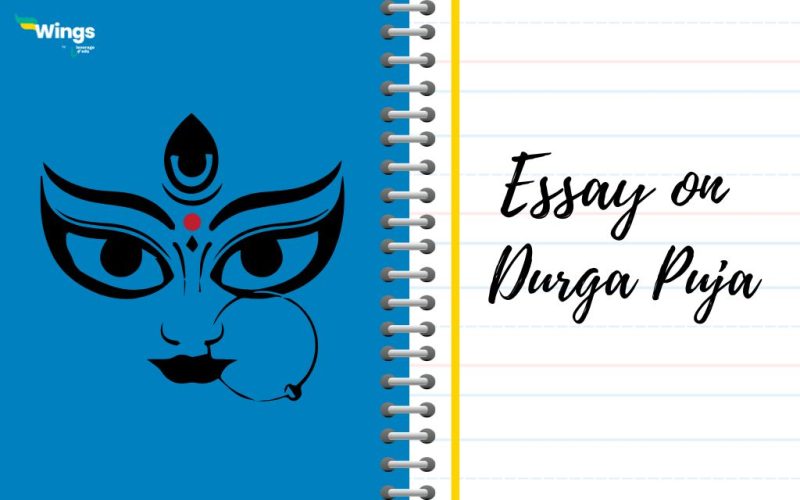Essay on Durga Puja: Durga Puja is a major Hindu festival in India, celebrating the triumph of Goddess Durga over the demon Mahishasura. Lasting around ten days, the festival features elaborately crafted idols of the goddess in decorative pandals.
It combines religious fervour with cultural performances, including music, dance, and traditional rituals. The event unites communities and showcases India’s rich heritage, emphasizing the victory of good over evil and fostering a sense of togetherness among people from various backgrounds. The festival concludes with the immersion of the idols, symbolizing the goddess’s return to her divine abode.
Table of Contents
Must Read: Essay on the Importance of Education
Why is Durga Puja Celebrated?
Indians celebrate Durga Puja to honour and worship Goddess Durga, a symbol of divine feminine power and strength. The festival holds immense religious significance as it commemorates the victory of Goddess Durga over the demon Mahishasura, signifying the triumph of good over evil.
Durga Puja is also a cultural extravaganza that brings communities together. It provides a platform to showcase intricate artistry, craftsmanship, and creativity through the creation of elaborate idols and beautifully decorated pandals. The festival showcases India’s rich cultural heritage, as well as its unity in diversity, as people from various backgrounds and regions participate in the celebrations.
Beyond its religious and cultural aspects, Durga Puja fosters a sense of togetherness and camaraderie. Families, friends, and neighbours come together to worship, enjoy cultural performances, and partake in festive feasts. The celebration promotes social bonding, instils a sense of community, and strengthens the fabric of society.
In summary, Durga Puja is celebrated in India to honour Goddess Durga’s valour, revere the concept of good prevailing over evil, showcase cultural richness, and foster unity among diverse communities. It’s a multifaceted festival that blends spirituality, art, culture, and social harmony into a vibrant tapestry of celebration.
Also Read: Essay on Waste Management
200 Words Essay on Durga Puja
Durga Puja, a prominent Hindu festival, celebrates the victory of Goddess Durga over the demon Mahishasura. It is observed with immense fervour and enthusiasm across India, especially in West Bengal. The festival spans ten days, with the last five being the most significant. Elaborately crafted idols of Goddess Durga are worshipped in beautifully decorated pandals, temporary structures set up for the occasion. The atmosphere is filled with devotion, cultural performances, and traditional rituals.
The festival’s essence lies in the portrayal of the triumph of good over evil. It brings communities together, fostering a sense of unity and cultural heritage. Devotees dressed in traditional attire, visit pandals, offer prayers, and partake in festive feasts. The immersion of idols in water bodies symbolizes the goddess’s return to her celestial abode.
Durga Puja transcends religious boundaries, attracting people of all backgrounds. It showcases India’s rich art, culture, and craftsmanship, with intricate idols and mesmerizing decorations. The festival also has economic significance, generating employment opportunities and boosting local businesses.
In conclusion, Durga Puja is more than a religious event; it’s a cultural extravaganza that binds communities, promotes artistry, and commemorates the triumph of good over evil. It exemplifies the diversity and unity that defines India’s cultural landscape.
400 Words Essay on Durga Puja
Durga Puja, one of the most awaited Hindu festivals, holds a special place in the hearts of millions across India and beyond. It is a celebration of the goddess Durga’s victory over the demon Mahishasura, symbolizing the triumph of good over evil. The festival’s essence lies not only in its religious significance but also in its cultural and social dimensions.
The preparation for Durga Puja begins weeks in advance. Skilled artisans meticulously craft the idols of Goddess Durga and her four children, Lakshmi, Saraswati, Ganesha, and Kartikeya. These intricately designed idols are then installed in beautifully adorned temporary structures known as pandals. Each pandal boasts a unique theme, often inspired by mythology, current events, or artistic concepts. The pandals are a feast for the eyes, displaying remarkable creativity and craftsmanship.
The festival spans ten days, with the last five days being the most significant. Elaborate rituals and ceremonies are performed, invoking the goddess’s blessings. Devotees dressed in traditional attire gather at the pandals to offer their prayers, seek blessings, and immerse themselves in the festive atmosphere. Cultural performances, including music, dance, and theatre, are organized, adding to the vibrant ambience.
Durga Puja is not limited to religious sentiments; it transcends societal boundaries. People from diverse backgrounds and communities come together to participate in the festivities. The festival promotes a sense of unity and brotherhood, fostering an environment of communal harmony. It also contributes to the local economy, generating employment opportunities and boosting businesses related to decoration, food, and clothing.
The grand finale of Durga Puja is the immersion of the idols in water bodies. This symbolizes the goddess’s return to her celestial abode, accompanied by prayers for her swift return the following year. The immersion procession, or “Visarjan,” is a sight to behold, marked by music, dance, and a mix of emotions.
In conclusion, Durga Puja is more than a religious event; it’s a cultural extravaganza that encapsulates India’s diversity, artistry, and unity. It showcases the fusion of tradition and modernity, reinforcing the importance of preserving our cultural heritage. The festival’s celebration of righteousness prevailing over wickedness and its power to unite people from all walks of life make it a truly remarkable and cherished occasion.
Must Read: Essay on Indian Freedom Struggle – 100,200,500 Words
FAQs
Ans. Durga Puja is usually celebrated during the Hindu month of Ashwin, which corresponds to September or October in the Gregorian calendar. The festival typically spans ten days, culminating in the immersion of the idols on Vijayadashami day.
Ans. Durga Puja holds both religious and cultural significance. It honours Goddess Durga’s victory over the demon Mahishasura, symbolizing the triumph of good over evil. The festival also showcases India’s rich artistry and craftsmanship through intricately designed idols and creatively themed pandals. Beyond its religious aspects, Durga Puja fosters a sense of unity, bringing people of diverse backgrounds together to celebrate.
Ans. Durga Puja is celebrated with great enthusiasm. Elaborately crafted idols of Goddess Durga are installed in intricately decorated pandals. Devotees visit these pandals to offer prayers, seek blessings, and participate in various rituals. Cultural performances, including music, dance, and theatrical presentations, add to the festive ambience. The celebration culminates with the immersion of the idols in water bodies, accompanied by processions and celebrations.
We hope that this blog essay on Durga puja has given you some known and unknown facts and secrets about Durga puja. For more amazing daily reads that will help you build your IQ and improve your reading and writing skills, study tuned with Leverage Edu.
 One app for all your study abroad needs
One app for all your study abroad needs













